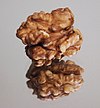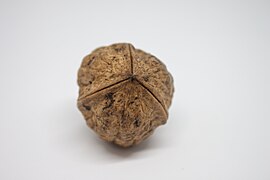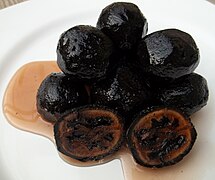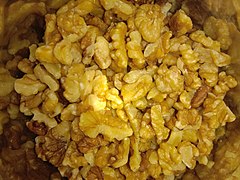Walnut





A walnut is the edible
After full ripening, the shell is discarded, and the kernel is eaten. Nuts of the eastern black walnut (Juglans nigra) and butternuts (Juglans cinerea) are less commonly consumed.
Description
Walnuts are the round, single-seed
Walnut trees are late to grow
Chemistry
Walnut hulls contain diverse
Walnuts also contain the ellagitannin,
Similar species
The
Species
The three species of walnuts most commonly grown for their seeds are the Persian (or English) walnut (J. regia), originating from Iran, the black walnut (J. nigra) – native to eastern North America – and the Japanese walnut, also known as the heartnut (J. ailantifolia).[6] Other species include J. californica, the California black walnut (often used as a rootstock for commercial propagation of J. regia), J. cinerea (butternuts), and J. major, the Arizona walnut. Other sources list J. californica californica as native to southern California, and Juglans californica hindsii, or just J. hindsii, as native to northern California; in at least one case, these are given as "geographic variants" instead of subspecies (Botanica).[citation needed]
Numerous walnut
The black walnut is of strong flavor, but due to its hard shell and poor hulling characteristics, it is not commercially cultivated in orchards.[citation needed]
| Country | Production (millions of tonnes) |
|---|---|
| 1.10 | |
| 0.66 | |
| 0.39 | |
| 0.33 | |
| 0.14 | |
| World | 3.50 |
| Source: FAOSTAT of the United Nations[8]
| |
Cultivation
In 2021, world production of walnuts (in shell) was 3.5 million
History
During the
Storage
Walnuts, like other tree nuts, must be processed and stored properly. Poor storage makes walnuts susceptible to insect and fungal mold infestations; the latter produces aflatoxin – a potent carcinogen. A batch that contains mold-infested walnuts should be entirely discarded.[2]
The ideal temperature for the extended storage of walnuts is −3 to 0 °C (27 to 32 °F) with low humidity for industrial and home storage. However, such refrigeration technologies are unavailable in developing countries where walnuts are produced in large quantities; walnuts are best stored below 25 °C (77 °F) with low humidity. Temperatures above 30 °C (86 °F) and humidity levels above 70 percent can lead to rapid and high spoilage losses. Above 75 percent humidity threshold, fungal molds that release dangerous aflatoxin can form.[2][11]
Cultivars
- Ashley
- Chandler[12]
- Cisco[12]
- Dawson[12]
- Eureka[12]
- Feradam
- Ferbel
- Ferjean
- Fernette[12]
- Fernor
- Ferouette
- Forde[12]
- Franquette[12]
- Grandjean[13]
- Germisara
- Gillet[12]
- Hansen
- Hartley[12]
- Howard[12]
- Hu
- Ivanhoe[14]
- Jupanesti
- Lara
- Livermore
- Marbot
- Mayette[15]
- Meylanaise[15]
- Paradox
- Parisienne
- Payne[12]
- Poe[12]
- Robert Livermore[12]
- Rita
- Ronde de Montignac
- Royal
- Serr[12]
- Sexton[12]
- Solano[12]
- Sunland[12]
- Tehama[12]
- Tulare[12]
- Valcor
- Vina[12]
- Wilson's Wonder
- Yolo
Uses
Culinary

Walnut meats are available in two forms: in their shells or de-shelled. Due to processing, the meats may be whole, halved, or in smaller portions. All walnuts can be eaten on their own (raw, toasted, or pickled), or as part of a mix such as muesli, or as an ingredient of a dish: e.g. walnut soup, walnut pie, walnut coffee cake, banana cake, brownie, fudge. Walnuts are often candied or pickled. Pickled walnuts that are the whole fruit can be savory or sweet depending on the preserving solution.
Walnuts may be used as an ingredient in other foodstuffs. Walnut is an important ingredient in
Walnuts are also popular as an ice cream topping, and walnut pieces are used as a garnish on some foods.[16]
Nocino is a liqueur made from unripe green walnuts steeped in alcohol with syrup added.
Walnut oil is available commercially and is chiefly used as a food ingredient, particularly in salad dressings. It has a low smoke point, which limits its use for frying.[17][18]
Nutrition
 Walnut kernel, halves | |
| Nutritional value per 100 grams | |
|---|---|
| Energy | 2,738 kJ (654 kcal) |
13.71 g | |
| Starch | 0.06 g |
| Sugars | 2.61 g |
| Dietary fiber | 6.7 g |
65.21 g | |
| Saturated | 6.126 g |
| Monounsaturated | 8.933 g |
| Polyunsaturated | 47.174 g 9 g 38 g |
15.23 g | |
Niacin (B3) | 7% 1.125 mg |
| Pantothenic acid (B5) | 11% 0.570 mg |
| Vitamin B6 | 32% 0.537 mg |
| Folate (B9) | 25% 98 μg |
| Vitamin B12 | 0% 0 μg |
| Vitamin C | 1% 1.3 mg |
| Vitamin E | 5% 0.7 mg |
| Vitamin K | 2% 2.7 μg |
| Minerals | Quantity %DV† |
| Calcium | 8% 98 mg |
| Iron | 16% 2.91 mg |
| Magnesium | 38% 158 mg |
| Manganese | 148% 3.414 mg |
| Phosphorus | 28% 346 mg |
| Potassium | 15% 441 mg |
| Sodium | 0% 2 mg |
| Zinc | 28% 3.09 mg |
| Other constituents | Quantity |
| Water | 4.07 g |
| †Percentages estimated using US recommendations for adults,[19] except for potassium, which is estimated based on expert recommendation from the National Academies.[20] | |
Walnuts without shells are 4% water, 15%
While English walnuts are the most commonly consumed, their nutrient density and profile are generally similar to those of black walnuts.[22][23]
Unlike most nuts, which are high in
Health effects
Health claims
In 2004, the US
In 2011, a scientific panel for the
Research
A 2020 systematic review assessing the effect of walnut supplementation on blood pressure (BP) found insufficient evidence to support walnut consumption as a BP-lowering strategy.[29]
As of 2021[update], the relationship between walnut consumption and cognitive health is inconclusive.[30]
Inks and dyes
Walnut husks can be used to make durable ink for writing and drawing. It is thought to have been used by artists including Leonardo da Vinci and Rembrandt.[31]
Walnut husk pigments are used as a brown
Woodworking
The fine, straight-grained wood of the black walnut is highly valued for furniture, wall paneling, automobile interiors, and gunstocks.[34]
Cleaning
The
Commercially, crushed walnut shells are still used outside of aviation for low-abrasive, less-toxic cleaning and blasting applications.[36] In the oil and gas industry, deep bed filters of ground walnut shell are used for "polishing" (filtering) oily contaminates from water.[37]
Cat litter
At least two companies, LitterMaid and Naturally Fresh, make
Folk medicine
Walnuts have been listed as one of the 38 substances used to prepare Bach flower remedies,[42] a herbal remedy promoted in folk medicine practices for its supposed effect on health. According to Cancer Research UK, "there is no scientific evidence to prove that flower remedies can control, cure or prevent any type of disease, including cancer".[43]
In culture
Large, symmetrically shaped, and sometimes intricately carved walnut shells (mainly from J. hopeiensis) are valued collectibles in China where they are rotated in hand as a plaything or as decoration. They are also an investment and status symbol, with some carvings having high monetary value if unique.[44] Pairs of walnuts are sometimes sold in their green husks for a form of gambling known as du qing pi.[45]
Gallery
-
Common walnut in growth
-
California black walnut in growth
-
A three-segment shell which occurs rarely
-
Walnut in shell and a nutcracker utensil used to break the shell
-
Video of cracking a walnut
-
Walnut meats
-
Broken walnut meats
-
Applesauce coffee cakegarnished with walnuts
-
Walnuts as collectibles
-
Murabba made from young walnuts
-
Loose Walnut kernel in West Bengal, India.
References
- ^ a b Grant, Amy (19 April 2021). "Walnut Tree Harvesting: When Are Walnuts Ready To Pick". Gardening Know How. Retrieved 4 December 2021.
- ^ a b c "Walnut; Agriculture – Transport Information Service". Association for German Insurance. 2010. Archived from the original on 14 February 2015.
- from the original on 29 July 2017.
- PMID 15656654.
- .
- ISBN 9780660198583.
- ^ "Commodity Profile: English Walnuts" (PDF). AgMRC, University of California. 2006. Archived (PDF) from the original on 12 March 2012.
- ^ a b "Walnut (in shell) production in 2021, Crops/Regions/World list/Production Quantity (pick lists)". UN Food and Agriculture Organization, Corporate Statistical Database (FAOSTAT). 2023. Retrieved 9 July 2023.
- ^ Geoponika - Agricultural Pursuits. Vol. 2. Translated by Owen, Thomas. London: University of Oxford. 1806.
- OCLC 780050566.
- ^ "Food, Nutrition & Agriculture – Prevention of aflatoxin". FAO, United Nations. 1998. Archived from the original on 7 March 2011.
- ^ a b c d e f g h i j k l m n o p q r s t "Walnut Cultivar Table". Fruit and Nut Information Center, Department of Plant Sciences, University of California, Davis. 2018. Archived from the original on 8 February 2018. Retrieved 6 March 2018.
- ^ fr:Le Verger Francais tomme II Chapitre I Fruits Locaux & Regionaux 1948
The French en:Orchard Book II Chapter I Local & Regional Fruits 1948 - ^ US active USPP21718P2, Gale McGranahan & Charles Leslie, "Walnut tree named 'Ivanhoe' (patent)", published 2011-02-22, issued 2011-02-22, assigned to THE REGENTS OF THE UNIVERSITY OF CALIFORNIA
- ^ a b Le Verger Francais, Tome 1 Catalogue Descriptif des Fruits Adoptes 1947
- ISBN 978-1-61564-486-5. Archivedfrom the original on 31 March 2018. Retrieved 27 May 2017.
- ^ "Walnut oil recipes". BBC. Archived from the original on 17 February 2014. Retrieved 3 July 2014.
- ^ Turner, Lisa. "Oil Change". Better Nutrition. Archived from the original on 6 July 2014. Retrieved 5 July 2014.
- ^ United States Food and Drug Administration (2024). "Daily Value on the Nutrition and Supplement Facts Labels". Retrieved 28 March 2024.
- )
- U.S. Department of Agriculture (28 October 2018). "FoodData Central: Nuts, walnuts, English, halves, raw". fdc.nal.usda.gov. Retrieved 27 June 2023.
- ^ a b "Nutrition facts: Nuts, walnuts, English dried per 100 g". Archived from the original on 5 July 2014. Retrieved 4 July 2014.
- ^ "Nutrition facts: Nuts, walnuts, black, dried per 100 g". Archived from the original on 5 July 2014. Retrieved 4 July 2014.
- ^ "Labeling & Nutrition - Qualified Health Claims: Letter of Enforcement Discretion - Walnuts and Coronary Heart Disease (Docket No 02P-0292)". wayback.archive-it.org. Office of Nutritional Products, Labeling and Dietary Supplements. 9 March 2004. Retrieved 11 March 2024.
- ^ Tarantino, Laura M. (9 March 2004). "Qualified Health Claims: Letter of Enforcement Discretion – Walnuts and Coronary Heart Disease (Docket No 02P-0292)". US Food and Drug Administration, Labeling and Nutrition. Archived from the original on 7 May 2017. Retrieved 30 April 2017.
- ^ Wagner, Roberta (22 February 2010). "FDA Warning Letter to Diamond Food, Inc". US Food and Drug Administration, Inspections, Compliance, Enforcement, and Criminal Investigations. Archived from the original on 12 January 2017. Retrieved 1 November 2016.
the evidence supporting a relationship between walnuts and coronary heart disease is related to the omega-3 fatty acid content of walnuts. There is not sufficient evidence to identify a biologically active substance in walnuts that reduces the risk of coronary heart disease. Therefore, the above statement is an unauthorized health claim
- . Retrieved 11 March 2024.
- ^ European Commission (2012). "Food and Feed Information Portal Database | FIP | Health Claim 1155". ec.europa.eu. Retrieved 12 March 2024.
- S2CID 219539797.
- PMID 34132152.
- ^ "Black Walnut Ink Workshop". Guild of Natural Science Illustrators. October 2002. Archived from the original on 9 October 2014. Retrieved 3 July 2014.
- ^ "The Colors of Invention – How to Dye Fibers Naturally". Smithsonian Museum. 13–16 November 1997. Archived from the original on 21 October 2014. Retrieved 3 July 2014.
- ISBN 978-0-313-33145-9. Retrieved 3 July 2014.
walnut.
- ^ Williams, Robert D. (1980). "Black walnut". US Department of Agriculture. Retrieved 29 August 2021.
- ^ "In Re Air Crash Disaster at Mannheim Germany on 9/11/82. Ursula J. Schoenborn, As Executrix of the Estate of Leonedward Schoenborn, Deceased, v. the Boeing Company. Appeal of the Boeing Company. United States Court of Appeals, Third Circuit. 769 F.2d 115". Justia. 1985. Archived from the original on 17 May 2014. Retrieved 10 April 2014.
- ^ "OSHA fact sheet addresses abrasive blasting hazards". Retrieved 20 August 2018.
- ISBN 978-1-119-36353-8.
- ^ Parks, Shoshi (24 October 2022). "The best natural cat litter we tested with our pets". Insider.
- ^ n.a. (26 May 2023). "What is the best walnut cat litter". Winston-Salem Journal.
- ^ n.a. (26 May 2023). "What are the pros of walnut cat litter?". Buffalo News.
- ^ n.a. (26 May 2023). "What are the cons of walnut cat litter?". SCNow.
- ISBN 978-81-7021-271-3. Archivedfrom the original on 31 December 2013. Retrieved 2 September 2013.
- ^ "Flower remedies". Cancer Research UK. 26 January 2015. Archived from the original on 11 September 2013. Retrieved 1 September 2013.
- ^ Subler, Jason; Lee, Jane Lanhee (28 August 2012). "Status-conscious investors shell out on great walnuts of China". Reuters. Archived from the original on 14 November 2015.
- S2CID 148515450.
Further reading
- Ramos, David D. (1997). Walnut Production Manual. UCANR. ISBN 978-1-879906-27-3.
- Smith, Jane S. (2009). The Garden of Invention Luther Burbank and the Business of Breeding Plants. Penguin Books. ISBN 978-0-14-311689-9.
External links
- "Walnut" at the Encyclopedia of Life












